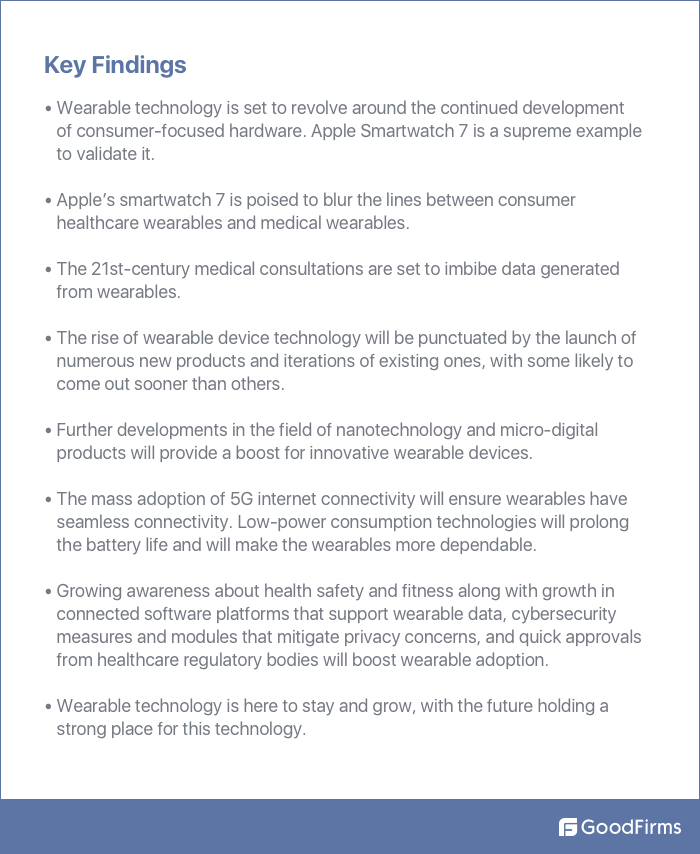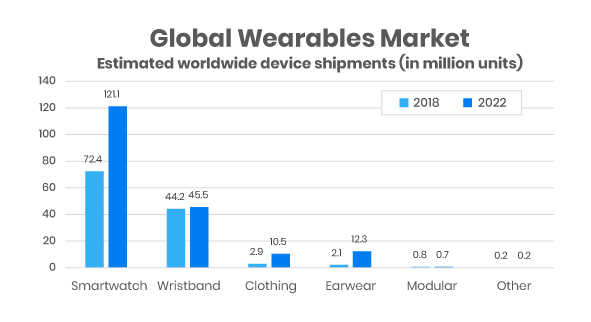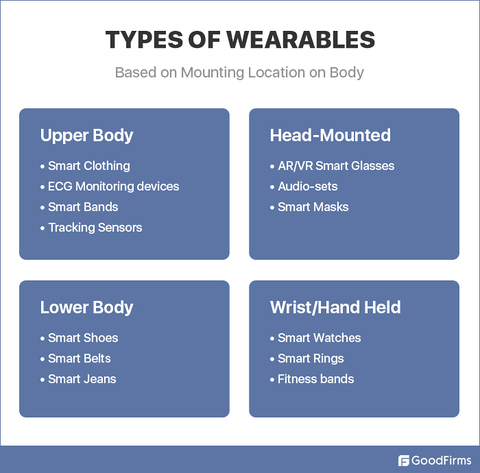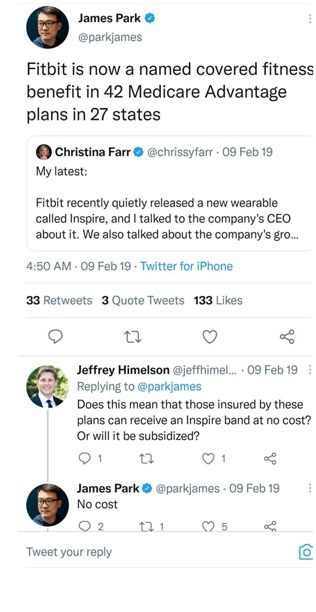Abstract:
Consumer enthusiasm, market growth, and transformation are the three factors that contribute to innovative product deliveries. But, above all, successful organizations are those that create new opportunities against continued uncertainty. Wearable technology is one unique technology that has been seeing steady growth and acceptance. Apple is one brand that has been undoubtedly strengthening the wearable market against all odds, more specifically with its latest Apple Watch Series 7 product. This research article examines the current wearable segment, popular products, current use cases, potential barriers, consumer perception, enthusiasm, and more. It also analyzes how Apple’s watch 7 benefits the wearable sector. This research article further investigates how technological development, such as miniaturization, 5G, nanotechnology, etc., will boost the industry.

Table of Contents:
POPULAR SEGMENTS OF CONSUMER WEARABLE DEVICES
CURRENT MARKET OPPORTUNITIES FOR All WEARABLES
- Occupational Health Safety and Health Standards
- Thought-Controlled Robotic Wearables
- Baby Monitoring
- Geofencing
- Authentication
- Defense
- Transmit Volumes of Clinical Data
- Detect Mental Health through Social Interaction Tracking
- Assistive Technology for People with Disabilities
- Early Detection of Diseases
- Stress Cancelling Technology
- Self-monitoring of Body Vitals
CURRENT BARRIERS IN THE WEARABLE SECTOR
APPLE's SMARTWATCH 7 POISED to BOOST CONSUMER HEALTHCARE TECH
FUTURE IMPLICATIONS FOR WEARABLE TECHNOLOGY:
KEY FINDINGS
CONCLUSION
Introduction:
Back in 1961, a mathematician from MIT came up with a “roulette shoe,” which was recorded as the first wearable (computational) technology. Today, we see a clear-cut shift of computing paradigms across sectors, more specifically with AI. The word “wearables” seems to be a misnomer today as it is used so much more than the act of wearing technology. This research is a simple attempt to put forth the shifting narratives and purposes of this growing technology – WEARABLE TECHNOLOGY.
With 5G on the verge of massive expansion, wearables have got the fuel they need for faster data transfers, flawless synchronization, and enhanced wearable experience.
Apple’s Smartwatch Series 7 Launch
Apple’s smartwatch 7 launch(1) is a significant event in the wearable domain, especially in the smartwatch wearable segment. The newest variant of the iconic Apple Watch, and so far its best, the Apple Watch 7 got launched on September 14, 2021. With an array of functionalities and features such as smart sensors, Advanced WatchOS, miniaturization, embedded communication technologies, and multiple-functionalities, Apple Watch 7 undoubtedly stands as the inspiration of the future of wearable technology.
Wearables- An Overview
Wearable technology is a branch of the computer science field that refers to the interaction between computers and the human body. The technology tends to augment ordinary body-worn devices with advanced information and communication capability. It includes wearable items such as sensors, cameras, microphones, smartwatches, and other devices which sense a person's physical, emotional, and behavioral data. Wearables are miniaturized devices that can be donned on the body for purposes ranging from fitness, gaming, medical to entertainment and industrial utilities.
The Fitbit tracker launched in 2009 is the first commercial instance of how wearable tech got into a larger action and how connectivity, mobility, communication, connection computing amalgamated to create a device that can be sold into the consumer space.
While consumer wearables such as fitness bands, smartwatches, clothing wearables, etc., are mostly used for physical activity tracking, sophisticated and clinically approved wearables are used for routine to intricate medical care. Consumer wearables are redefining the parameters of the health behavior assessment. While there is a clear convergence between consumer wearables and health/medical wearables, both vary in terms of precision.
High Degree of Precision Makes Consumer Wearables Different From Medical Wearables
The latest June 2021 research paper collaborated by the Imperial College of London and Institute of Molecular Science and Engineering mentions that due to a high level of precision(2), medical wearables 'can be used to improve the care and survival of cardiovascular disease.’
As medical wearables are subjected to multiple levels of regulations, their precision level is comparatively higher than the wellness wearables such as fitness bands or smartwatches.
Global Wearable Market
The below image details the estimated shipment of wearable devices by 2022 and its relative comparison with 2018. Smartwatches, fitness bands, clothing, earwear are indicated to grow higher compared to other wearables such as smart glasses.

Source- (Global data 2021)
Popular Segments of Consumer Wearable Devices
Fitness Trackers:
Fitness trackers are electronic wearables that measure, track, and store physical activity data and are popularly used for meeting fitness goals by sportspersons, fitness enthusiasts, and people with medical conditions that demand timely monitoring of activities. The use cases of fitness trackers range from blended learning for personalized fitness lessons to motivation for physical activities.
Smartwatches:
Smartwatches have been around for nearly a decade now, but they’ve only recently become mainstream. With the release of the Apple Watch in 2015, smartwatches became more popular than ever. Usually synced to your mobile phone, Smartwatches are designed to be versatile and can track your activity, gauge current fitness levels, monitor your heart rate, play music, send messages, emails, provide news updates, weather conditions, etc. They come with functionality to download apps that make them even more useful. From tracking the location of your connected phone to using it as an alarm clock, timekeeping, calculator, and more, smartwatches deliver on multiple fronts.
21% of US online adults use a smartwatch or fitness tracker.(3)
Smart Jewellery
Smart jewelry that comes in the form of rings, bracelets, bangles, earrings, etc., is a health-tracking device that is capable of monitoring health-related data with the help of sensors fitted within the body of the ornament.
Smart Clothing
Smart Garments have fabrics that allow digital components and sensors to be implanted on them and come with advanced healthcare features such as EKG heart rate monitoring technology and smart motion sensors, pulse oximetry, etc.
- Detect Pathogens and Toxins
Smart clothes can also detect pathogens and toxins.(4) Researchers from the Wyss Institute and M.I.T. have created clothing fabric that uses a synthetic biology-based sensor fitted into clothing materials and textiles. These smart clothing can detect deadly pathogens such as the SARS-CoV-2 virus and toxins.

(Source)
The below image shows the types of wearables people use based on their mounting location on the body:

(Source)
Current Market Opportunities for All Wearables
Industry wearables with integrated AI, IoT, AR, and sensor technologies such as smart glasses, bands, headsets, gloves, head-mounted displays, etc., are already raising industry productivity, improving safety standards and quality of work. For example, a mine worker with a head-mounted smart wearable helmet can send real-time data, video, or images to the site office. The wearable device can send moisture information, the pressure conditions inside the mine, stress levels, heart rate, fatigue info about the miners, etc.
Occupational Health Safety and Health Standards
With quantifiable real-time health information of oxygen levels, pulse rate, etc., administrators can track and prevent any health hazard before it leads to injury or fatality. In low visibility environments or loud industrial sites, smart wearables with advanced audio technologies can keep communication stable and effective. Not only can it improve the parameters of safety for deep digging miners but also increase the site visibility for office administrators. It also enables industries to meet the mandatory regulatory requirements for maintaining occupational health safety and health standards.(5) Smart wearables that detect sleep and alertness levels for drivers in the logistics industry can mitigate the risks of accidents due to fatigue-induced sleep while driving.
As Mark Bernstein, Founder & CEO of Wearable Technologies Ltd., says, "Smart wearables make a huge difference to workers' safety and productivity. What's most exciting is removing the danger and drudgery from people's jobs."(6)
Wearables can deliver on three fronts:
- Tracking employee location on huge sites
- Monitoring health status of individual employee
- Capturing real-time work environment data
Thought-Controlled Robotic Wearables
Robotic wearables or bionic robots are wearable devices that are revolutionizing the post-surgery recovery and convalescence process. The thought-controlled robotic arm(7) is a reality now. Other types of exoskeleton robots with human-like motions also have exciting applications in defense, heavy industries, etc. These wearables can reduce the impact of strenuous activities in these fields.
Baby Monitoring
Another potential use case of wearables is in baby monitoring.(8) Sensors fitted in baby wearables such as clothes, bands, sleepsuits can monitor vital signs and send alerts to parents sleeping in nearby rooms or working in offices.
Geofencing
Wearables for pet animals, kids, or people with diseases such as Alzheimer’s can create a geofencing guard that warns when users move out of the marked area. Apple Watch, Fitbit devices also come with GPS trackers that assist in navigation during travel.
Authentication
The authentication experience takes a more advanced shape with smart wearable tattoos that can be scanned.(9) Wearables such as smartwatches can also authenticate the payment. Wearables such as smart glasses, smartwatches, and smart clothing are also being used for authentication for unlocking smart safes, smart homes, etc. Disney’s Magic band is an example of how wearables can unleash authentication without hassle.

(Source- DisneyWorld)
Defense
In the defense industry, smartwatches, smart clothing, and protective gears enable monitoring of soldiers’ exact location, body vitals, hydration levels, muscle strain, etc. Wearables attached to arms and legs can help soldiers carry more weight without straining their bodies.
Wearables in Healthcare
The healthcare wearables segment derives its fuel from the increasing desire of consumers to continuously monitor their health-related parameters on their own.
Most wearables in healthcare are primarily used for:
- Remote patient monitoring for basic body measures such as blood pressure, pulse rate, oxygen levels, temperature, etc.
- An early diagnosis which is later confirmed by actual tests and medical evaluation
- Continuous monitoring and health-data collection for chronic diseases
- Helping patients in adherence to medication by timely alerts and notifications
- Boosting health by alerts for drinking water, food, calorie information, etc.
- Tracking fitness goals, exercise time, and physical activity measurement
- Reducing insurance premiums by providing the fitness activity information of the insured to the insurers.
Transmit Volumes of Clinical Data
One area that stands to benefit most is remote monitoring of large numbers of people. Wearable devices can transmit volumes of clinical data – blood pressure, respiratory rate, oxygen levels, pulse, blood pressure, and body temperature.(10)
Detect Mental Health Through Social Interaction Tracking
While wearables may be helpful in tracking, they have the potential to detect mental health too. Recently, we have seen the use of wearables for detecting mental health problems, such as bipolar disorder and depression. As a secondary diagnostic device, wearables can identify the severity of depressive symptoms based on social interaction tracking via Bluetooth,(11) sleep duration, stress, etc.
Assistive Technology for People with Disabilities
Wearable tech is often used as assistive technology to help people with disabilities navigate their world more easily. Wearables offer features like voice activation, navigation tools, and sensors that provide important information about the environment. This makes it easier for people with disabilities to engage in activities like socializing, working, and transportation on their own terms.
Early Detection of Diseases
Many studies have proven the effectiveness of wearable devices in the early detection of diseases such as Parkinson’s.(12) Wearables can also detect early signs of illness in CoVID19.(13)
Stress Cancelling Technology
CoVID 19 prompted many innovations in the wearable segment. Smart masks creators added voice amplifiers in masks to enable clear communication while wearing masks. Wearables that come with stress canceling technology(14) and sleep-enhancing effects are also an outcome of COVID19 induced sleep disorders and higher stress levels.
Self-Monitoring of Body Vitals
Wearable technology has been used by healthcare practitioners for some time now, but it is finally becoming more popular among the general public. These gadgets can be used to monitor all sorts of things, including your blood pressure, your heart rate, the activity in your lungs, and even your stress levels.
Studies have shown that this type of technology can help people achieve their exercise goals, but more research is needed to see if it is effective for weight loss.
Patients who are wearing activity trackers or smartwatches show an
- improved reaction time
- improved exercise adherence,
- improved cognitive capacity.
- more likely to engage in physical activity
- higher levels of self-esteem and confidence.
The importance of wearables can be gauged from the fact that medical insurance companies are now incentivizing those donning wearables to track their physical activity data and are willing to share the data with the insurer. Also, the fitness tracker companies are partnering with insurance firms to provide free or discounted wearables on buying insurance from their partner insurers.

Source-Twitter
Apple’s strong positioning will be backed by its competitive advantage achieved with its unique features, superior design, and brand value. Compared with the broader watch market, the Apple Watch 7 series dilutes the risks associated with mediocre products, and market perception regarding Apple makes it a preferable brand for consumer healthcare wearable choice. Apple also brings reliability, comfort, and perfect user experience to the table with the upgraded Apple 7 series smartwatch.
Apple’s Smartwatch 7 Poised to Boost Consumer Healthcare
Apple Watch is the Company’s line of smartwatches based on its watchOS® operating system. Apple’s smartwatch is another step forward in blurring the lines between consumer healthcare wearables and medical wearables. Let us first see its features and how it is technically superior to its predecessors:
Latest Apple Watch 7 and its Features:
The next-generation wearable powered by WatchOS 8 is proposed to retail at $399 for its 41mm variant and $429 for the 45mm variant. Apple Watch 7 has the largest display (20% more than Watch 6) in comparison to its predecessors and comes with an Always-on 70% brighter display. This watch is made with carbon-neutral technology and comes with features that help users track physical activities, workout sessions, and understand their health conditions in a better way.
With a spacious design, Apple has accommodated the QWERTY keyboard that can be tapped or swiped with QuickPath for typing purposes. When it comes to sturdiness and durability, this Apple Watch surpasses its earlier versions with a new crack-proof crystal coating and IPX6 certification for dust resistance.
Apple Watch 7, however, retains the same sensors such as the Apple Watch 6, same battery life (18 hours), same storage (32GB), same apps and monitoring elements such as ECG app, Blood Oxygen app, heart rate, Water resistance (WR 50m), sleep tracking, and fall detection.
The Company silently clarifies the following points:
- Blood Oxygen app measurements are not intended for medical use, including self-diagnosis or consultation with a doctor, and are only designed for general fitness and wellness purposes.
- The ECG app (similar to a single-lead electrocardiogram) is intended for use by people above 22 years.
- Irregular rhythm notification requires the latest version of watchOS and iOS. It is not intended for use by people under 22 years old or those who have been previously diagnosed with atrial fibrillation (Afib).
In September 2020, the Company announced Apple Fitness+SM, a personalized fitness service built for Apple Watch.(17)
So, do wearable devices improve physical activities?
The lack of physical activity causes approximately $117 billion in annual health care costs to the USA alone. The physical activity guidelines for Americans lay down measurable activity needs for Americans based on scientific evidence.(18) Wearables can help in achieving those ‘measurable physical activity requirements’ by providing tracking assistance. As most fitness goals or daily fitness routines require consistency and monitoring for quantifiable results, fitness trackers are a popular and easy solution for the same.
For example, setting up a goal of 10000 steps a day and tracking it with a fitness wearable. Apple Watch 7’s step tracking and the flagship fall detection feature will further motivate other wearable makers to explore the potentials of fitness tracking.
Whether wearables are fashion accessories or really valuable body devices?
Body-worn sensors, devices, and sensors embedded within smart devices are expanding the scope of how we communicate with the world. With the advent of the large-scale app development process, sophisticated and reliable hardware and software elements boosted by Apple Watch 7, more health care professionals will soon favor the consumer wearable data. The ease of use and strong potential for personalized care is creating an enthusiasm among more and more consumers to invest in such wearables.
Apple Watch can benefit medical heart research
A research study at the Royal Institute Sweden concluded- “Apple Watch can benefit medical heart research with big sets of relatively correct data, and if the medical study is able to include more patients it could even result in big data. This data can give researchers a broad vision of a patient’s physical activity patterns that could lead to conclusions that regard improvements in quality-of-life and life length for patients with failing hearts.”(19)
Future Implications for Wearable Technology:
Porter's five competitive forces model, named after Harvard business school professor Michael E. Porter(20) can be applied to the wearable segment -
#To understand the level of competition within the industry and gauge its future
The wearable technology segment is witnessing a lot of traction from startups such as Eargo, One Drop, real wear, GOQii, etc., to global players such as Nike, Google, Samsung, Apple, etc. As the popularity of wearables rises, the industry will receive more funding, more investors, and wearable players will come up with technically more advanced products. Samsung, Google, and Sony have all released their own smartwatches that run on their own flagship OS. Other fitness giants such as Fitbit, Noise, Fire Boult, etc. are driving direct competition into the wearable segment.
#To continuously invest in research and design
Wearable segment players will have to constantly research and iterate their design, failing which they will risk losing the market to new entrants.
#To balance the distribution equation between suppliers and OEMs
The segment is also a highly supplier-dependent market where even the major players are dependent on suppliers for sensors, miniature components, circuits, etc. The future of wearable tech also depends on how the equation between suppliers and OEMs turns out.
#To differentiate products
In a highly competitive industry structure, the only way to combat multiple forces (new entrants, current players, substitutes, consumer bargaining power, etc.) is to differentiate products. A standout product can defend itself against all antagonists in the market. How wearable companies differentiate their product and come up with better and unique products will be key to gaining market share in the wearable segment.
#To adhere to policies and compliance
As the gap between healthcare wearable devices and consumer wearable devices is narrowing down, wearable makers will have to wade through various tests for functionality, quality, efficacy, safety, and reliability. Companies that create wearable products that can meet guidelines and regulatory requirements set by healthcare regulatory agencies such as FDA, MHRA, and data privacy regulators such as GPDR will be able to win the profit race in the long term.
What About Consumer Enthusiasm?
Consumer enthusiasm is undoubtedly high for wearables and is driving growth for the market.(21) Purchase intent and consumer excitement are critical for the growth of any industry. As price points in the wearable segment become more affordable, companies can expect broader consumer participation as buyers. The pandemic has already made people more conscious about chronic ailments, heart conditions, hypertension, and other health and fitness-related elements. Augmented needs for self-monitoring and preponderance for chronic disease conditions are adding to consumer enthusiasm for self-service wearable devices.
Will wearables transform a lot more industries, workplaces, and even the way we shop? Nielsen Insights on retail begins with an interesting question -- “In the future, will your wearable device recommend what to add to your grocery list?”(22) This is just the beginning of a new world where we might see smartphones getting replaced by wearables and wearables becoming ubiquitous devices in our life.
Various other studies (see references section) analyzed bring us to the following key findings about wearables, their future, with a focus on smartwatches.
Key Findings
- Despite its non-invasive nature, much of the future of wearable technology is set to revolve around the continued development of consumer-focused hardware. Apple Smartwatch 7 is a supreme example to validate it.
- The 21st-century medical consultations are set to imbibe data generated from wearables. As long as wearable manufacturers try to standardize their equipment to match medical research and provide a sustainable framework for bagging regulatory approvals, the chances of medical inclusion of consumer wearables are pretty high.
- Apple got FDA approval(23) for Apple Watch 4 series, and soon Fitbit also got FDA 510 (k) approval for its ECG application.
- Apple’s smartwatch 7 launch is another step forward in blurring the lines between consumer healthcare wearables and medical wearables.
- The rise of this technology will be punctuated by the launch of numerous new products and iterations of existing ones, with some likely to come out sooner than others.
- Further developments in the field of nanotechnology and micro-digital products(24) will provide a boost for wearable devices. The nano biosensors and miniaturization of materials used to create wearables reduce the bulkiness of wearables and make their everyday use feasible.
- The mass adoption of 5G internet connectivity will ensure wearables have seamless connectivity.
- Low-power consumption technologies will prolong the battery life and will make the wearables more dependable.
- With a stream of health-conscious users popularizing smart wearables for watching their lifestyle and physical activities, medical practitioners will find many patients kicking in with self-diagnosis based on wearable validation.
- The conditions that boost wearable adoption include:
- Miniaturization of sensors
- Growing awareness about health safety and fitness
- Quick approvals from healthcare regulatory bodies
- Technologies that boost battery life
- Development of components that enhance wearable durability
- OS improvements to increase processing speeds of the wearables
- Growth in connected software platforms that support wearable data
- Cybersecurity measures and modules that mitigate privacy concerns
Developments in the above factors will eventually make these advancements more desirable from a user standpoint.
Conclusion:
Apple sold 43 million watches in 2020. Revenue wise the third Quarter of 2021 had sales of 8775 million(25) in comparison to 6450 million in the same quarter last year. Apple’s contribution towards the uplifting of the wearable market is notable. The wearable tech market itself is forecasted to grow to 54 Billion Dollars by 2023.(26) Wearable technology has become very popular among the public as a reflection of our appetite for more and more connected devices.
Furthermore, with a constructive approach towards high-end wearable devices along with regulatory backing, wearables will integrate seamlessly into modern healthcare systems. The potential applications for wearable technologies are infinite. From measuring personal fitness goals to monitoring body vitals, we can’t wait to see what comes next. Apple Watch 7’s user survey can be a substantial research topic to understand the correlations between fitness, medical use, and experience with smart wearables.
Declaration of conflict
GoodFirms declares that we have no conflicts of interest to report regarding the present study.
About GoodFirms’ Research:
GoodFirms is the global leader in IT research and listing. We empower businesses everywhere with high-quality research insights that unleash competitive advantage for businesses. Our research aims to provide the right strategies, best practices, and deep expertise to businesses for their exceptional growth.
References:
- https://www.apple.com/newsroom/2021/09/apple-reveals-apple-watch-series-7-featuring-the-largest-most-advanced-display/
- https://spiral.imperial.ac.uk:8443/handle/10044/1/88893
- https://www.forrester.com/report/the-state-of-consumers-and-technology-2020/RES163595
- https://wyss.harvard.edu/media-post/wearable-synthetic-biology-clothing-that-can-detect-pathogens-and-toxins/
- https://www.osha.gov/workers
- https://uk.linkedin.com/in/markbernstein
- https://futurism.com/mind-controlled-robotic-arm-johnny-matheny
- https://www.researchgate.net/profile/Md-Nakib-Ul-Hasan-2/publication/343040161_Wearable_Technology_for_Baby_Monitoring_A_Review/links/5f12984092851c1eff1ba1ca/Wearable-Technology-for-Baby-Monitoring-A-Review.pdf
- https://duoskin.media.mit.edu/duoskin_iswc16.pdf
- https://hbr.org/2019/05/the-health-care-benefits-of-combining-wearables-and-ai
- https://ubicomp.org/ubicomp2014/proceedings/ubicomp_adjunct/posters/p23-chen.pdf
- https://www.ncbi.nlm.nih.gov/pmc/articles/PMC5018102/
- https://med.stanford.edu/news/all-news/2020/12/smartwatch-can-detect-early-signs-of-illness.html
- https://www.prnewswire.com/news-releases/feelmore-labs-introduces-cove-a-breakthrough-wearable-device-that-effortlessly-reduces-stress-and-improves-sleep-301101707.html
- https://www.pwc.com/ee/et/publications/pub/pwc-cis-wearables.pdf
- https://www.nature.com/articles/s41746-021-00418-3.pdf
- https://s2.q4cdn.com/470004039/files/doc_financials/2020/ar/_10-K-2020-(As-Filed).pdf
- https://health.gov/sites/default/files/2019-09/Physical_Activity_Guidelines_2nd_edition.pdf
- http://kth.diva-portal.org/smash/get/diva2:1129454/FULLTEXT01.pdf
- https://www.hbs.edu/faculty/Pages/profile.aspx?facId=6532
- https://www.idc.com/getdoc.jsp?containerId=prUS47534521
- https://nielseniq.com/global/en/insights/analysis/2019/the-2020-vision-for-u-s-retail-and-beyond/
- https://www.businesswire.com/news/home/20200914005215/en/
- https://www.researchgate.net/publication/350521667_An_Overview_of_the_Miniaturization_and_Endurance_for_Wearable_Devices
- https://s2.q4cdn.com/470004039/files/doc_financials/2021/q3/FY21_Q3_Consolidated_Financial_Statements.pdf
- https://store.globaldata.com/report/gdtmt-tr-s219--wearable-tech-thematic-research/




